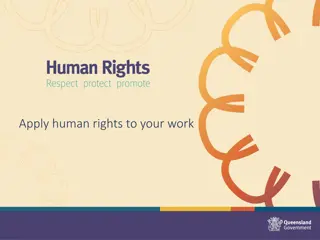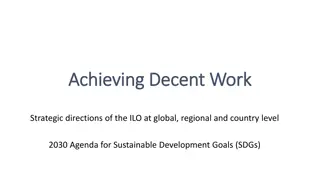Global Forum on Migration and Decent Work: A Human Rights Approach
The Global Forum on Migration and Development in 2020 explored the intersection of migration and decent work from a human rights perspective. The dialogue highlighted the significant number of international migrant workers globally and emphasized the importance of addressing the root causes of migration through promoting fair treatment and protection mechanisms for migrant workers. The International Labour Organization (ILO) plays a crucial role in ensuring social partners are involved in migration policy-making, advocating for a tripartite approach to labor migration that integrates workers' rights, skills development, job creation, education, and social protection.
Download Presentation

Please find below an Image/Link to download the presentation.
The content on the website is provided AS IS for your information and personal use only. It may not be sold, licensed, or shared on other websites without obtaining consent from the author. Download presentation by click this link. If you encounter any issues during the download, it is possible that the publisher has removed the file from their server.
E N D
Presentation Transcript
Decent work and labour migration DIALOGUE ON MIGRATION AND DECENT WORK: THE HUMAN RIGHTS APPROACH XII GLOBAL FORUM ON MIGRATION AND DEVELOPMENT 20 January 2020 Universidad Andina Sim n Bol var Quito Ecuador
Basic data on labour migration 2017: 258 million international migrants (source: United Nations Department of Economic and Social Affairs Population Division) Most migration is directly or indirectly related to the world of work ILO estimates around 164 million migrant workers (stock figures), with more men (58.4%) than women (41.6%) migrant workers (ILO Global estimates on migrant workers, 2018) Migrant workers are concentrated in particular economic sectors: construction, manufacturing, agriculture, hotel and catering, health and care work, domestic services.
Distribution of migrant workers, by broad sub-region (2017) Source: ILO Global Estimates on International Migrant Workers Results and Methodology. 2nd ed. International Labour Office -Geneva: ILO, 2018 Source: ILO Global Estimates on International Migrant Workers Results and Methodology. 2nd ed. International Labour Office -Geneva: ILO, 2018
ILO approach on migrants Migration is oftentimes the result of a decent work deficit in the countries of origin; migration should be the result of a choice, not a necessity Interest of the ILO in migrants as workers: promote fair (non discriminatory) treatment of the workers ILO is neutral as concerns the desirability of migration for employment: ILO has no stake in pushing for more migration or less migration; ILO s standards define what protection mechanisms should kick in once migration does take place
ILOs tripartite approach In the area of migration, ILO seeks to make sure that the social partners are involved in migration policy making, including at the national and local level (not only internationally); capacity building of workers and employers organizations as well as Ministries of Labour to this effect.
ILOs tripartite approach Labour migration, by its very nature, is interwoven with overall labour market policies and specific policy areas such as workers rights, skills development and skills recognition, job creation, education and vocational training and social protection. The International Labour Organisation (ILO) advocates for labour migration to be addressed as a labour issue by labour authorities in collaboration with social partners employers and workers organizations and other relevant actors.
A rights-based approach ILO standard setting contribution to migration Constitutional mandate to protect migrant workers: Preamble to the Constitution 1919: the protection of the interests of workers when employed in countries other than their own . All ILO Conventions are applicable to migrant workers, unless otherwise stated in the Convention (e.g. Convention on indigenous people only applies to this group) Especially rights as they are defined under the 1998 ILO Declaration on Fundamental Principles and Rights at Work apply to all migrants, including even in irregular situations (these concern freedom of association and collective bargaining; the elimination of child labour and forced labour; non-discrimination). Two Conventions dealing directly with migrant workers - Migration for Employment (Revised), 1949 (No. 97) and Migrant Workers (Supplementary Provisions) Convention, 1975 (No. 143)
Decent Work and Migration An integrated approach on migrant workers issues ILO action on international labour migration is based on 4 interrelated pillars, the Decent Work Agenda: Fundamental principles and rights at work Employment Social protection Social dialogue This allows the ILO to address issues as varied as migrants working conditions; rights of collective representation; labour market mobility and integration; migrant workers skills development; social security for migrant workers and their families, including portability of benefits; remuneration; and remittances, to name but a few.
Fair migration Making migration a choice and not a necessity, by creating decent work in countries of origin Respecting the human rights, including labour rights, of all migrants Ensuring fair recruitment and equal treatment of migrant workers to prevent exploitation and level the playing field with nationals Forging stronger linkages between employment and labour migration policies Having Ministries of Labour, trade unions and employers organizations involved in policy making on migration Fostering genuine cooperation between countries and within regions























